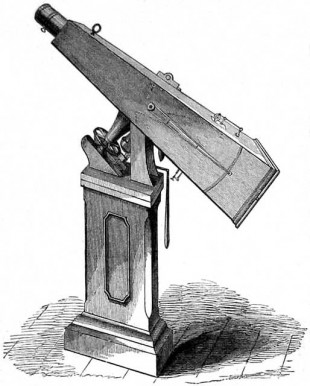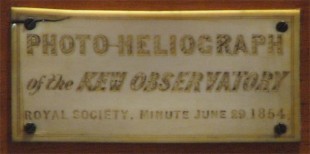…where east meets west
- Home
- Brief History
- The Greenwich Meridian
- Greenwich
(1675–1958) - Herstmonceux
(1948–1990) - Cambridge
(1990–1998) - Outstations (1822–1971)…
- – Chingford (1822–1924)
- – Deal
(1864–1927) - – Abinger
(1923–1957) - – Bristol & Bradford on Avon
(1939–1948) - – Bath
(1939–1949) - – Hartland
(1955–1967) - – Cape of Good Hope
(1959–1971)
- Administration…
- – Funding
- – Governance
- – Inventories
- – Pay
- – Regulations
- – Royal Warrants
- Contemporary Accounts
- People
- Publications
- Science
- Technology
- Telescopes
- Chronometers
- Clocks & Time
- Board of Longitude
- Libraries & Archives
- Visit
- Search
Telescope: The Kew Photoheliograph (1854)
Comissioned in 1854, the Kew Photoheliograph was the World’s first astronomical instrument specifically constructed for photographing celestial objects. Designed for solar photography, it is named after the Kew Observatory, where it was originally housed and used. It was loaned to the Royal Observatory, Greenwich, from around the start of 1873 until 1876 and has been in the care of the Science Museum, London, since 1927 (Inventory No.1927-0124).
The Kew Observatory and the instrument’s early history
Originally built so that King George III could observe the Transit of Venus in 1769, the Observatory at Kew was put under the control of the British Association in 1842 and a magnetic observatory established. By the early 1850s, the results from Kew and elsewhere suggested a strong link between magnetic disturbances and the appearance of sunspots. General Sabine, who had discovered the link was keen to investigate this further. As a result, in 1854, following an intervention by Sir John Herschel, a new type of instrument was commissioned for the purpose of obtaining daily photographs of the Sun. Paid for by the Royal Society from funds put at its disposal by Benjamin Oliveira, it was designed by the astronomer and chemist Warren de la Rue (1815–89) and constructed by the London Instrument maker Andrew Ross, the final cost being about £180. By 1856, it had been completed and erected at Kew ready for initial trialling. Sometimes referred to as ‘the sun-spot photographing apparatus’, it subsequently became known as the Kew Photoheliograph. Initially, much experimentation was required to produce consistently good images. Due to pressures of work, the photoheliograph did not become fully operational until March 1858. However, because of staffing difficulties, it was not used on a daily basis until several years later.
Description of the instrument
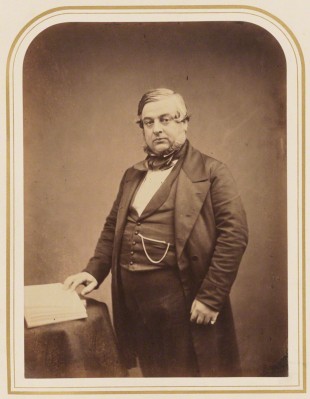
Warren de la Rue by Maull & Polyblank, albumen print, 1855. © National Portrait Gallery, London. Reproduced under a Creative Commons Attribution-NonCommercial-NoDerivs 3.0 Unported (CC BY-NC-ND 3.0) licence (see below)
‘The object-glass of this instrument is 3 4/10 inches aperture and 50 inches focal length; it is not corrected for achromatism in the ordinary manner, but so as to produce a coincidence of the visual and photogenic foci. The secondary objectives for magnifying the image produced by the principal object-glass are of the Huyghenian form. They are three in number, producing respectively images of the sun 3, 4, and 8 inches in diameter. Between the two lenses of each of these secondary object-glasses is inserted a diaphragm-plate carrying the fixed micrometer wires, which are of platinum; these wires are four in number, two at right angles to the other two. One of the wires of each pair is in such a position that they may both be made tangential to the sun's image, while the other two cross at a point situated near the sun's centre. By means of these wires, the distance in arc between each pair having been once for all ascertained astronomically for each secondary object-glass, it will be easy to determine all the data necessary for ascertaining the relative magnitudes and positions of the sun’s spots. These micrometer wires are under the influence of springs, so as to preserve a tension upon them when expanded by the sun’s heat, and thus to keep them straight.
The principal and secondary object-glasses are not mounted in an ordinary cylindrical tube, but in a pyramidal trunk square in section, 5 inches in the side at the upper end, which carries the principal object-glass, and 12 inches in the side at the lower end, which carries the photographic plate-holder and the usual ground glass screen for focusing.
This trunk is firmly supported by a declination axis of hard gun-metal 2½ inches in diameter; it is furnished with a declination circle 10 inches in diameter, reading to one minute of arc, and has a clamp and screw motion for fine adjustment in declination.
The declination axis works in Y-bearings at the top of the polar axis, which is 12 inches long; it is 4 inches diameter at its upper end and I½ inch at its lower end. The lower end fits with a slight taper into a brass collar up to a shoulder, the friction being reduced by a steel spring plate pressing against a hardened steel hemisphere at the end of' the axis.
It will be seen by the above description, that every precaution has been taken to secure stiffness in the telescope combined with freedom in the motion of the polar axis. The polar axis is driven by a clock driver, which answers perfectly, and is easy of regulation to the greatest nicety, so that the sun’s limb remains for a long period in contact with the tangential wires. Near the lower end of the polar axis is fixed the hour-circle, which, like the declination circle, is 10 inches in diameter; it is graduated to read to 2 seconds of time. An endless screw, making about two revolutions in one minute, geers into the hour-circle and connects it with the clock. As it is generally necessary to make small corrections in right ascension after the tangent screw has been geered with the driving clock, in order to bring the sun’s image in position with respect to the micrometer wires, a sliding plate is provided which carries the bearings of the tangent screw; this is acted upon by a second fine screw parallel with the tangent screw; so that by rotating the second screw, the sliding plate and the tangent screw are moved through a small space, and the hour-circle thus caused to rotate to the extent necessary for bringing the sun’s image in position.
The clock is driven by two weights, one pulling upwards over a pulley, the other downwards, thus suspending the barrel and equalizing the pull and avoiding friction on its bearings. By causing the click of the winding lever to abut on the ratchet-wheel of the going part of the clock during the period of winding, the clock goes at its normal speed while it is being wound.
The mode of regulating the clock is extremely simple and efficacious; it is effected by approaching to, or withdrawing from, a hollow cone over a small wheel, on which are attached, by means of flat springs, two small weights, which expand by centrifugal force and come in contact with the inside of the hollow cone.
The polar axis of the telescope is carried by a dial-plate which fits on the top of a hollow column of cast iron, the section of which is a parallelogram. This column is securely fastened to the stone foundation. The instrument is mounted within the rotating dome of the Kew Observatory, which has been repaired and put in order for that purpose. photographic dark room is at present too distant from the telescope, but it is contemplated to construct close to it, as serious inconvenience has been already experienced in the preliminary experiments in consequence thereof.
The telescope and its mechanical appliances may be said to be perfect so far as they go, but experience will undoubtedly suggest several minor alterations and additions before the telescope is brought practically to work. The photographing of such minute objects as the sun’s spots will require at all times the utmost skill and care of an accomplished photographer, even when the telescope has been fairly started. The difficulties yet to be mastered must occupy some considerable time. The first attempts have been confined to the production of negative photographs, but in consequence of the imperfections always existing in the collodion film, it has been deemed advisable to make attempts to produce positive pictures, and recourse may ultimately have to be made to the Daguerreotype process.’
Writing in 1859 after much experimentation had been carried out, De La Rue went on to describe more about the adjustment and how the exposure was made:
‘It has been found, after repeated trials, that the best photographic definition is obtained when the sensitized plate is situated from 1/10th to 1/8th of an inch beyond the visual focus in the case of a 4-inch picture; and that when this adjustment is made, beautiful pictures are obtained of the sun 4 inches in diameter, which still bear magnifying with a lens of low power and show considerable detail on the sun’s surfaces besides the spots, which a re well defined.’
‘The image is not received directly on the sensitive plate, as is the case in taking lunar and planetary photographs, but is enlarged before it reaches the plate, by means of a secondary lens, which magnifies the sun’s image to about four inches in diameter. The time of exposure is so short, that there is a necessity for a special contrivance for regulating the time of exposure. This is effected by means of a. sliding-plate placed just before the secondary lens. In this plate is a slit which is adjustable in width. The plate before taking the picture is held up by means of a thread. In this position the light is shut off from the sensitive plate. When the picture is about to be taken the retaining thread is set fire to, and a spring pulls the plate rapidly across the secondary lens. The time of exposure depends on the rapidity of passage of the sliding-plate before the secondary lens.’
Early photographic process
The photoheliograph images were all captured using the recently invented colloidon photographic process rather than the earlier Daugerreotype and Calotype ones. This produced images that were not only superior to Caloypes, but unlike Daugerrotypes, could also be reproduced as they were formed on glass rather than metal plates. The main downside was that the plates which had to be used wet, had to be prepared as and when required and then exposed and developed before the plate dried out. This normally meant that there was only around 15 minutes to complete the whole process, necessitating the presence of a darkroom close to hand.
The 1860 eclipse
In 1860, detailed plans were put in place to take the photoheliograph to Rivabelossa in Spain to photograph the solar eclipse that was due on 18 July. This necessitated the construction of a new iron pillar adapted to the latitude of Rivabelossa. In order to make it easier to transport, the pillar was made in sections that could be bolted together on site. A wooden house measuring 8.5 feet square and 7 feet high was also constructed to house the instrument. This was open at the top except for a portion divided off as a photographic dark room, the roof being covered by a canvas when the instrument was not in use. Amongst those in the party were De La Rue, Beckley, Reynolds, George Downes a photographer from the Bond Street firm of Cundall and Downes and Clark who acted as interpreter and assisted during the eclipse.
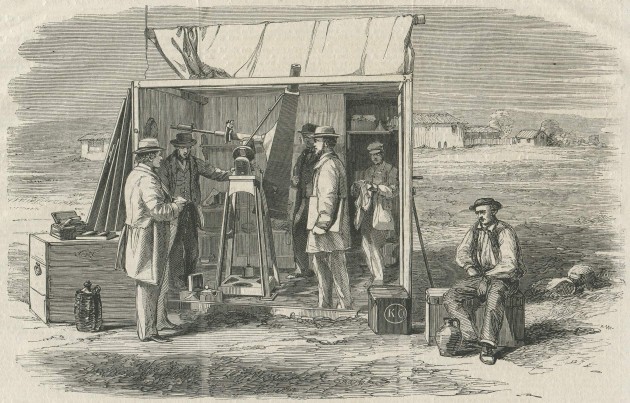
The Kew Photoheliograph at Rivabellosa. Left to right: De La Rue, Beckley (observing the chronometer at his feet), Clarke (holding a taper to burn the thread which triggered the exposure), Reynolds (holding a plate holder ready to place in telescope), Downes (who is standing in front of the entrance to the dark room and who prepared and developed the plates) and unknown (fictitious?). The 'lightweight' iron pedestal was left behind when the instrument was returned to England. Copied from a photograph with reasonable accuracy and a slight degree of rearranging, this woodcut was published in the The Illustrated London News on 25 August 1860 (p.170). Prior to the photograph being taken, the front boards of the observing hut were removed to allow the photoheliograph to be seen
At the time of the expedition, it was not known whether the prominences visible during a solar eclipse were part of the Sun, or an effect of the Earth’s atmosphere. By comparing his photographs with those taken by Fr Angelo Secchi 500 km away at Desierto de las Palmas, De la Rue was able to establish that the prominences were intrinsic to the Sun. Click here to read De la Rue’s write up of the expedition
A note on the known images of the photoheliograph at Rivabellosa
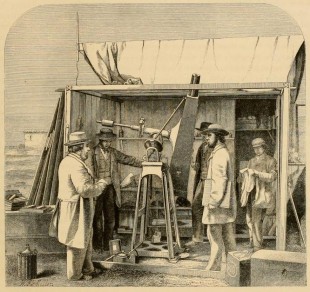
The Kew Photoheliograph. From The Bakerian Lecture: On the Total Solar Eclipse of July 18th, 1860, Observed at Rivabellosa, Near Miranda de Ebro, in Spain. Warren de la Rue, Phil. Trans. R. Soc. Lond. (1862)
The only ‘editing’ that seems to have taken place in the 1862 woodcut is the removal of two partial figures that appear in the photograph to be leaning against the right hand side of the hut.
The 1860 woodcut on the other hand has a number of changes that have made at the hands of the engraver. For example, a single weight has been substituted in error for the two weights of the clock drive and the distant hut on the left of the figure is inaccurately reproduced. More interesting, is the section of the woodcut to the right of the hut. This does not appear in the RAS photograph. At least part of this has been based on a degree of artistic licence as the boxes bottom right have been rearranged. But what of the sitting figure and the distant buildings behind him? Nothing is known of their authenticity.
The 1860s and the temporary transfer to Cranford
Following the return of the Photoheliograph from Spain, pressure of work at Kew meant that there were few opportunities to use it. In light of this, and also because he was already geared up to carrying out celestial photography, De la Rue was asked by the Kew Committee to take charge of the instrument at his own private observatory at Springfield, his home in Cranford (which no longer exists, but was located near the Queen’s Head, a little over a mile to the north-east of the eastern end of the much later northern runway at Heathrow and four miles to the west of the observatory at Kew: click here for map). This was agreed to by De la Rue, provided it did not interfere with his other work. The instrument arrived at Cranford in January 1862, with the first pictures being obtained on 7 February. It was used there on a regular basis until 7 February 1863, by which time proper provision was in the process of being put in place for the instrument to be used on a daily basis (weather permitting) at Kew. As well as sufficient staffing, this included a new photographic room on the roof near the Photoheliograph’s dome.
In August 1862, the Director of the Wilna Observatory in Russia stayed with De la Rue where he was given a training in astrophotography. At the same time a photoheliograph was ordered for Wilna from John Dallmeyer, the son in law of the late Andrew Ross, who had died in 1859. Its construction was overseen by De la Rue. Based on the Kew instrument and the experience gained in its use, the Wilma instrument incorporated various optical and mechanical improvements. It was completed and sent to Russia towards the end of 1863. With a second photoheliograph in a different location, the number of days each year on which a photograph could be obtained stood set to be increased. In reality however, the Wilma instrument remained largely unused until the late 1860s and was then destroyed by fire in 1876.
The programme of observations with the Kew Photoheliograph had been planned to run for ten years. 1872 was the year that it was due to come to an end. The date had originally been set for the end of February, but was extended to the end of March at de La Rue’s expense so that a full ten years worth of observations could be completed. In the event, the programme ran from 7 February 1862 to 9 April 1872.
Between 1862 and 1872, the number of days on which photographs were obtained was as follows (from Monthly Notices of the Royal Astronomical Society, Feb 1872 (Vol. 32, p.156)):
| Year | Days | Comment | ||
| 1862 | 163 | Pictures taken at Cranford | ||
| 1863 | 125 | Instrument returned to Kew in Feb, pictures recommenced May | ||
| 1864 | 164 | |||
| 1865 | 159 | |||
| 1866 | 157 | |||
| 1867 | 131 | No pictures taken during building works (9 Aug – 9 Sep) | ||
| 1868 | 174 | |||
| 1869 | 195 | |||
| 1870 | 220 | |||
| 1871 | 226 | |||
| 1872 | 10 | Figures relate to January only. The programme ceased a few weeks later |
||
| Total | 1724 |
In the same 1872 report, it was also anticipated that ‘after the lapse of a year or two, a new Photoheliograph, with all those improvements and perfections which advanced knowledge and past shortcomings have suggested’ would be erected somewhere in the United Kingdom by De la Rue. This was possibly in anticipation of purloining one of the recently ordered Transit of Venus Photoheliographs once they had been returned to the UK after the 1874 Transit (see below). In the meantime, the Royal Society sanctioned the replacement of the secondary magnifier of the Kew Instrument (an ordinary Huyghenian eye-piece) ‘with a positive eye-piece achromised for the chemical rays as in the Wilna Instrument’.
Against this background, it should be noted that In 1871 financial hardship had nearly brought all operations at the Kew Observatory to a halt. They were only saved by a private bequest of £10,000 and the transfer of administration from the British Association to the Royal Society. Given de La Rue’s decision to retire from active observational astronomy, the need for a new instrument and the absence of any obvious source of funding, there was little realistic prospect of the Kew programme being extended further.
The Transit of Venus photoheliographs
The 8 December 1874 Transit of Venus was the first to occur since 1769. Initial planning for a British expedition began with the publication of a paper by Airy in 1857 (click here to read). In 1868, Airy began a correspondence with the Hydrographer of the Navy about funding an expedition. Although there had been discussion of the application of photography, photographic methods were excluded from the estimate for the expenditure of a sum of £10,500 that was put before a parliamentary committee and approved on 6 August 1869 (click here for Hansard report). Not everyone was happy at the exclusion of photographic observations, particularly the Royal Observatory’s own Board of Visitors who at their meeting on 5 June 1869 had resolved:
‘that in their opinion it would be desirable to make provision for the Photographic record of the phenomena in addition to the preparations already contemplated.’ (ADM190/4)
and as a result, at their annual meeting on 4 June 1870, the Observatory’s Board of Visitors resolved that
‘Mr warren De la Rue be requested to confer with the Astronomer Royal with the view of organizing a plan for photographic observations of the Transit of Venus, and for preparing an approximate estimate of the probable expense.’ (ADM190/4)
At their next meeting on 3 June 1871, they went further and
‘Resolved, that as this Board deem it most important that Photographic be combined with eye observations at the approaching Transit of Venus, an opinion in which the Astronomer Royal fully concurs, the Chairman [Edward Sabine] apply to the Lords Commissioners of Her Majesty’s Treasury to sanction a grant of Five Thousand Pounds (£5000) for the purpose, a sum which it is considered will cover the cost of photographic apparatus and observations for all stations.’ (ADM190/4)
Following further correspondence with Airy, the Admiralty agreed to provide the additional £5000. At this point, an order was paced with Dallmeyer for five photoheliographs, their construction being overseen by De la Rue.
Airy bites the bullet – a photographic and spectroscopic department for Greenwich
Prior to 1872, Airy had shown no interest in instigating a programme of systematic observations of the Sun at Greenwich. This would probably have remained the case if it hadn’t been for: a) others exerting pressure on the Government for more publically funded science including a dedicated astrophysical observatory, b) the presence (since 1864) of De la Rue on the Board of Visitors, and c) the cessation of his programme at Kew.
In 1870, a Royal Commission had been set up to inquire into Scientific Instruction and the Advancement of Science. Often referred to as the Devonshire Commission, it sat from 1870–75 and produced a large number of reports.
In 1872, as the debate on the provision of a dedicated astrophysical observatory was reaching its climax, Airy made the pragmatic decision to try and fend off such an eventuality by suggesting to the Board of Visitors that the Observatory should undertake a continued series of observations of solar spots and possibly engage in solar spectroscopy as well. The Board endorsed his view at their meeting on 1 June as did the Admiralty. By the end of the year, construction of a dome to house a photoheliograph at Greenwich was under way.
Click here to read more about the photoheliographic programme and the debate of 1872.
History of the Kew instrument at Greenwich (1873–76)
Conscious as always that government money could be saved, rather than order a new photoheliograph specifically for the Royal Observatory, Airy planned in the long run to use one of the Dallmeyer Photoheliographs ordered for the Transit of Venus expedition. These however were not going to be permanently available for use at Greenwich until 1875 following their return from overseas. Once he was confident of parliamentary approval for the funding of the new area of work, he wrote in his capacity as Astronomer Royal to the secretary of the Royal Society, (George Stokes, who was also a member of the Observatory’s Board of Visitors), explaining the position and asking if he might borrow the Kew Photoheliograph in the interim. The letter was written on 19 October 1872 and his request discussed at the next meeting of the Society’s Council on 31 October. Since he was the Society’s President at that time, Airy himself was in the chair. After his letter had been read, Airy explained that he had previously been in touch with De la Rue who was happy for such a loan to take place. It was therefore resolved that his request be acceded to.
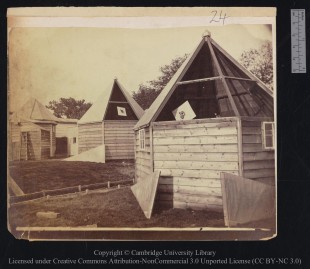
In this view, which dates from 1873 or 1874, the wooden building housing the Kew Photoheliograph is seen on the left standing on its brick foundations. To its right are huts for two of the Transit of Venus photoheliographs, the one on the right being destined for Station D (New Zealand). The viewpoint is from near the south-west corner of the Observatory site, looking across the South Ground towards the north-east. The low building behind the two huts on the left is the suite of seven Magnetic Offices. The low level fencing running from the bottom left hand corner marks the edges of a path. An engraving made from the photograph was published in The Graphic on 27 June 1874. Reproduced under the terms of a Creative Commons Attribution-Non-Commercial (CC BY-NC) licence courtesy of Cambridge Digital Library (see below)
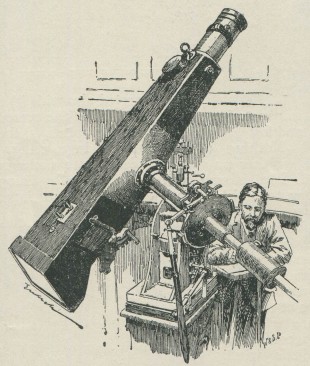
The Photoheliograph in its dome at Kew. From: Weather Watchers and their Work, The Strand Magazine, Vol.3, London, 1892, p.185
Although funding was available for an extra member of staff, the new assistant, E Walter Maunder, was not appointed until later, taking up post on 6 November 1873. Meanwhile, a regular programme of recording sunspots had commenced on 1 June 1873, with photographs of the Sun being taken with either the kew Photoheliograph and one or more of the Dallmeyers. Unfortunately, the published daily observations do not indicate which photoheliograph was used to obtain them. On 27 June 1874, the Kew Observatory sent Airy an ownership label which they asked him to attach to the woodwork of the Photoheliograph. It is believed to be the same label that is on the instrument today. (ROG6/63/205).
The Kew Photoheliograph was dismounted by Dallmeyer’s staff on 22 September 1875 and replaced by the Transit of Venus Photoheliograph that had been sent to New Zealand (RGO6/784, 1876 BofV Report p.9 & ADM190/4/402). It was subsequently returned to Kew on 5 January 1876.
Measuring the optical distortion
This section is currently in preparation.
Later History
Following its return from Greenwich at the start of 1876, the Photoheliograph was re-erected in its dome at Kew. Just a few weeks later, it was dismounted and sent together with a number of solar negatives to the Loan Exhibition at South Kensington. There it remained until 1882 when it was once again returned to Kew. From 3 July onwards it was used to record the position of sunspots not by photographic means, but by drawing their positions as they appeared projected on to the focussing screen. This programme was a continuation of one that had begun at Kew in 1872 with a telescope of 23/4-inch aperture following the cessation of photographic observations with the Kew photoheliograph. The new programme with the Kew Photoheliograph continued for 15 years before being brought to a close at the end of 1897. Over this period, the average number of days in each year on which observations were made was about 170. This was considerably lower than the number of days each year on which good photographs were obtained at Greenwich. In the 1890s, for example, the figure for Greenwich was around 30% higher.
Since 1927, the instrument has been in the care of the Science Museum in London.
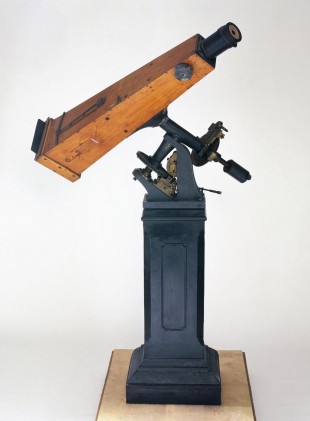
� The Board of Trustees of the Science Museum. Reproduced under the terms of a Creative Commons Attribution-NonCommercial-ShareAlike 4.0 Licence (CC BY-NC-SA 4.0), details below
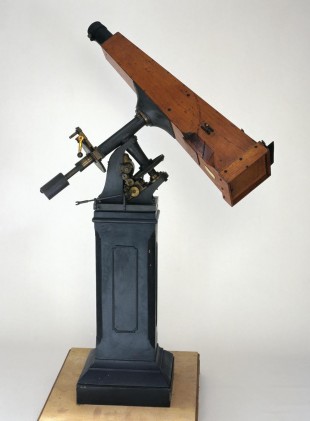
� The Board of Trustees of the Science Museum. Reproduced under the terms of a Creative Commons Attribution-NonCommercial-ShareAlike 4.0 Licence (CC BY-NC-SA 4.0), details below
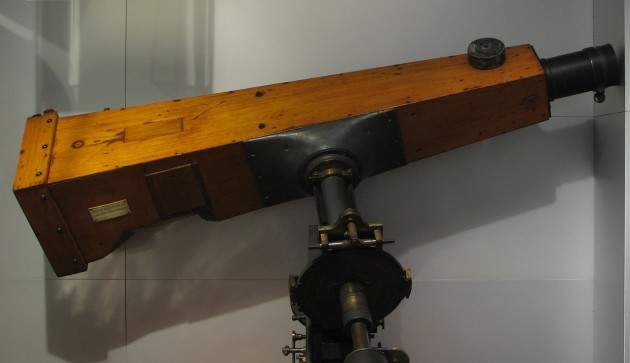
The Kew Photoheliograph on display in the Science Museum in 2016. Note the location of the ownership label (centre-left)
Contemporary accounts and further reading
On Celestial Photography. Warren de la Rue, Monthly Notices of the Royal Astronomical Society, Vol.19, pp.353–358 (1859)
The Bakerian Lecture: On the Total Solar Eclipse of July 18th, 1860, Observed at Rivabellosa, Near Miranda de Ebro, in Spain. Warren de la Rue, Phil. Trans. R. Soc. Lond. Vol. 152, pp.333–416 (1862)
Reports of the Kew Committee and of the Kew Observatory (1842–1924)
The Greenwich Photo-heliographic Results (1874 – 1976): Summary of the Observations, Applications, Datasets, Definitions and Errors. D. M. Willis, H. E. Coffey, R. Henwood, E. H. Erwin, D. V. Hoyt, M. N. Wild & W. F. Denig. Sol Phys (2013)
The Greenwich Photo-heliographic Results (1874 – 1885): Observing Telescopes, Photographic Processes, and Solar Images. D. M. Willis, M. N. Wild, G. M. Appleby & L. T. Macdonald. Sol Phys (2016)
Re-examination of the Daily Number of Sunspot Groups for the Royal Observatory, Greenwich (1874 – 1885). D. M. Willis, M. N. Wild & J. S. Warburton. Sol Phys (2016)
“Solar Spot Mania”: The Origins and Early Years of Solar Research at Kew Observatory, 1852–1860. Lee T MacDonald, Journal for the History of Astronomy, Vol 46, No.4 pp.469–490 (Nov 2015)
The first photographic eclipse?. Peter Hingley, Astronomy & Geophysics (A&G), Vol 42 (Feb 2001)
Two Guernseymen and Two Eclipses. D.O. Le Conte, Antiquarian Astronomer, Issue 4, pp. 55–68 (2008)
The Transit of Venus Enterprise in Victorian Britain. Jessica Ratcliffe, (Routledge, 2008)
Lord Wrottesley, F.R.S., Pioneer Statesman of Science. David Layton, Notes and Records of the Royal Society of London, Vol. 23, No. 2 pp. 230–246, (Dec 1968)
Image licensing information
Portrait of Warren de la Rue by Maull & Polyblank, albumen print, 1855. © National Portrait Gallery, London. Reproduced under a Creative Commons Attribution-NonCommercial-NoDerivs 3.0 Unported (CC BY-NC-ND 3.0) licence. National Portrait Gallery Object ID: NPG P120(38).
The image of the Kew Photoheliograph hut is reproduced in compressed form under the terms of a Creative Commons Attribution-NonCommercial 3.0 Unported License courtesy of Cambridge Digital Library (RGO6/276).
The two colour images of the Kew Photoheliograph on its orignal pier are modern museum photographs and are reproduced under the terms of a Creative Commons Creative Commons Attribution-NonCommercial-ShareAlike 4.0 Licence (CC BY-NC-SA 4.0) courtesy of The Board of Trustees of the Science Museum. The orignals have been cropped and rotated though 1º to straighten them.
© 2014 – 2025 Graham Dolan
Except where indicated, all text and images are the copyright of Graham Dolan
